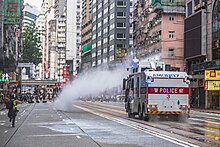
Back مسيرات هونغ كونغ في الأول من يوليو Arabic Marxes d'Hong Kong de l'1 de juliol Catalan Défilés du 1er juillet à Hong Kong French Mars 1 Juli Hong Kong ID Tuần hành ngày 1 tháng 7 tại Hồng Kông Vietnamese 七一遊行 Chinese 七一遊行 ZH-YUE
| Hong Kong 1 July marches | |||||||||
|---|---|---|---|---|---|---|---|---|---|
 Water cannons deployed during the Hong Kong 1 July march in 2020 | |||||||||
| Traditional Chinese | 七一大遊行 | ||||||||
| |||||||||
The Hong Kong 1 July protests was an annual protest rally originally held by the Civil Human Rights Front from the day of handover in 1997 on the HKSAR establishment day. However, it was not until 2003 that the march drew large public attention by opposing the legislation of Basic Law Article 23. The 2003 protest, with 500,000 marchers, was the second-largest protest seen in Hong Kong since the 1997 handover.[1]
Prior to this, only the pro-democracy protest on 21 May 1989 drew more people with 1.5 million marchers in Hong Kong sympathising with the participants of the Tiananmen Square protests of 1989.[2] The introduction of Article 23 legislation was left aside due to the protest. Since then, 1 July marches have been organised every year to demand for democracy, universal suffrage, rights of minorities, protection of freedom of speech, and a variety of other political concerns.
In 2019, the anti-extradition bill protest on 16 June broke the record of largest protest in Hong Kong with nearly 2 million marchers. The 1 July march in the same year with 550,000 marchers, was the largest 1 July march.[3] However, both these widely reported figures are now in doubt with research published by the Public Opinion Programme at The University of Hong Kong (HKUPOP) estimating that the attendance figures were 500,000-800,000 for the 16 June march[4] and 260,000 for 1 July.[5]
In 2020, despite a police ban citing gathering limits during the COVID-19 pandemic, and a dramatically altered legal situation due to the national security law that had come into force only the previous evening, marches with a total of tens of thousands of participants took place in several parts of the city. Police made more than 370 arrests, among which at least ten were on alleged violations of the new law.[6][7]
- ^ Wong, Yiu-Chung. One Country, Two Systems in Crisis: Hong Kong's Transformation Since the Handover. Lexington books. ISBN 0-7391-0492-6.
- ^ Williams, Louise. Rich, Roland. [2000] (2000). Losing Control: Freedom of the Press in Asia. Asia Pacific Press. ISBN 0-7315-3626-6.
- ^ "Unprecedented violence in Hong Kong as protesters storm legislature, police fire tear gas". South China Morning Post. 1 July 2019. Archived from the original on 2 July 2019. Retrieved 2 July 2019.
- ^ Scarr, Simon; Sharma, Manas; Hernandez, Marco; Tong, Vimvam (20 June 2019). "Measuring the masses - The contentious issue of crowd counting in Hong Kong". Reuters. Retrieved 4 February 2024.
- ^ "How many protesters took to the streets on July 1? Reuters measures the torrent of marchers". Reuters. 4 July 2019.
- ^ Creery, Jennifer (1 July 2020). "Hong Kong security law: 370 arrests, tear gas, pepper balls and water cannon as protesters ignore police ban". Hong Kong Free Press. Retrieved 3 October 2020.
- ^ "Hong Kong: First arrests under 'anti-protest' law as handover marked". BBC. 1 July 2020. Retrieved 3 October 2020.